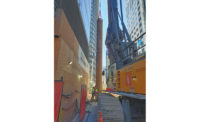With the lengthy and complex permitting and approval process complete and almost all the other details worked out, construction could begin in mid-November on the estimated $100-million shoring fix for the 645-ft-tall Millennium Tower in San Francisco. The perimeter pile upgrade for the 58-story residential condominium building, which has settled more than 17 in. toward the northwest since its completion in 2009, was originally expected to begin earlier this year.
“The city and state had a plethora of permit requirements for us,” says Ronald O. Hamburger, a senior principal with Simpson Gumpertz & Heger, the engineer-of-record for the fix. Hamburger’s client is Paul Hastings LLP, a lawyer retained by the tower’s developer, Mission Street Development. MSD is part of Millennium Partners.
The perimeter pile upgrade calls for transferring 20% of the building’s weight to bedrock from its existing foundation system, says Hamburger. The fix, likened to putting a bumper jack next to a flat tire, relies on drilling and jacking 52 concrete piles—socketed more than 30 ft into bedrock that starts 220 ft below grade—under the sidewalks along Mission and Fremont streets. Piles would support a new mat section, known as a collar, tied into the existing mat.
Unanimous Approval
To date, the project has been unanimously approved by the San Francisco Board of Supervisors, after earning corollary approvals from the Port of San Francisco and the State Lands Commission, according to Doug Elmets, a spokesman for the Millennium Tower Homeowners Association. The project also passed an environmental review under the under the California Environmental Quality Act.
There are three Dept. of Building Inspection permits secured, directly related to construction. One is for an indicator/test pile program; a second is for the required shoring and a third is for the actual construction.
There also is a secured building permit related to modifications to the interior of the building, regarding temporary changes to building access and egress related to the work.
Beyond that there are permits issued related to temporary sidewalk and traffic lane closures; relocation of utilities—specifically utility poles and overhead cables for the electric buses on nearby Fremont and Market streets; and the restoration of the sidewalk after construction.
Under the Sidewalk
The execution of the fix also includes closing on a land transaction between the city and the Millennium Tower Homeowners Association to allow construction and installation of the perimeter pile upgrade under the sidewalk. That has been authorized—as well as an agreement between the city and state to release the subsurface area from the state, says Elmets. This is because the subsurface has existed, historically, as part of the State Public Trust.
The dispute settlement documents have been finalized and executed by all parties, Elmets adds. The global settlement will be consummated on Aug. 7, upon final approval of the class action by the San Francisco Superior Court. The court has already given preliminary approval of the class action settlement and no delays are expected, says Elmets.
Construction contracts are complete and the prime contractor is in the process of securing a contractor-controlled insurance policy. Hamburger will not reveal the contractor's name.
"With all of the above, we have been expecting a start date around mid-November," says Elmets. "This could move up to October, if things move at a quicker pace."
Construction time is about two years. The first activities will be the utility pole relocations, followed by the test pile program.








